|
|
|
| |
| |
| |
| |
| LOHENGRIN 2010-08-17 |
|
|
I was not entirely unprepared. Had listened to a more than
satisfactory musical performance on BR4 on the evening of the premiere.
Had read all available reviews (which probably means everything,
since my source was a certain Mrs Marion Tung). Had listened to interviews
with the director and the singers involved. Knew that what I was going to
see was “controversial”, which is sometimes a good sign, sometimes not.
The headlines spoke of the “Lohengrin with the Rats”, which to me
and to most people sounds both unappealing and inappropriate. I knew that
I was to see neither “my” Lohengrin, nor that of Richard Wagner.
But what I had already read and heard suggested to me a key to the reading
of Hans Neuenfels (who is no fool), which I found useful. The key
figure is Charles Darwin (who most certainly was no fool) and who
established once and for all that we are descendants of the apes and that
even the rats are our distant relatives. A second key figure (as little a
fool as the two former) was Darwin’s contemporaray Arthur Schopenhauer,
who saw Man as what he is: an animal with a unique possibility,
unfortunately too weakly developed in most specimens or even totally
absent in some. The ability of abstract thinking, which makes it
possible for Man to see and understand the perspective of his “next”, even
that of his “enemies”. The acts of the animal are totally egoistic,
born from Instinct. Man is able to act unselfishly after reflexion.
Even against his own best, for the better of those who need a favour
better than himself. And – even worse - the animal who always acts from
instinct sees in violence not a problem but a useful mean.
I knew from reviews that a laboratory inhabited by masked people in
sterile dresses and rats living in cages played an important role in
Neuenfels’ staging. With my key I understood that the caged rats were as
much humans as every other living being on the stage. Neuenfels staged
“the Animal in Man”. Even the laboratory rats were humans. In a not
too distant past there were such laboratories, where medicines were tested
on humans. Not any human, of course, but those considered unworthy for one
reason or another.
During the Vorspiel - wonderful music describing sensations belonging to
another world and wonderfully played by the orchestra under Andris
Nelsons – the Lab was introduced. As was Lohengrin. A sterile white
wall with a door leading to a “scientists” laboratory, where experiments
on bacteria, viruses and - more probably - human genes could be performed.
Lohengrin – the only really human person on the stage - is obviously
resolved to enter at any cost, to see and to reveal what is going on
inside. Jonas Kaufmann, with his back to the audience pushing against the
closed door and the wall, performs a beautiful choreography which was
entirely in tune with the music. He makes no brusque movements. What we
see is a display of the power of intellectual determination. Slowly
he manages to push the wall back meter for meter. But the door remains
closed. When the strings of the Vorspiel reach celestial heights his
movements against the door become those of hands caressing the beloved.
And magically!! The door opens. Neuenfels had by then won me over. Love
and gentleness works better than muscular violence, he is saying. Violence
leads to nothing, Violence only feeds new violence. I would not dream of
booing the man. (As little as I would any performing artist doing his
job). |
|
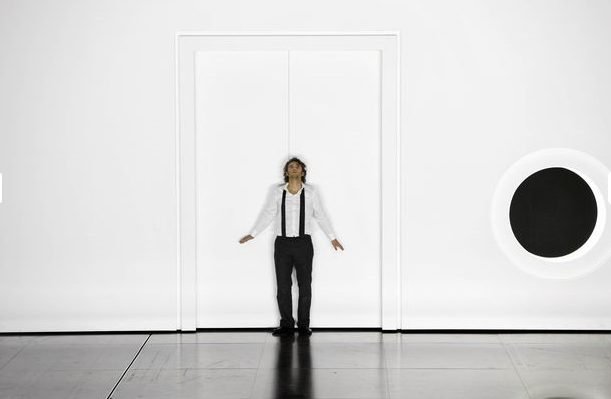 |
For the rest of the evening I saw only humans. In various
disguises. Any intelligent person knows that dress is only a mean
to conceal and betray and to impose on those who can be imposed upon. The
humans in this play and in this country of Brabant change dresses
according to the occasion. But the feet, the hands and the tails cannot
easily be concealed.
And Neuenfels speaks of mass suggestion. Of crowds willing to applaud and
hail a leader strong enough to make their animal hearts clap faster. King
Henry is no such leader. He is an epileptic suffering from “the falling
illness”. But he is a good person who sees what is right and what is
wrong. He is defended by his Heerrufer and we can even witness an attempt
on his life on the open stage. I’m glad that Neuenfels tries to make the
audience reflect on what “strength” really means. In a society of human
apes (or rats) only he who dares express opposition is strong. No strength
is needed to follow a majority. It is rather a sign of weakness.
Lohengrin is strong. He is a fully developed human being - with frailties
– but above all a man of Good Will and the determination to defend it. He
probably draws the sword against Telramund unwillingly, for the sake of
justice, but only then - when his muscular strength is obvious - the
Brabant crowd is willing to hail (Heil!) him as their leader (Fuehrer). |
|
* * * |
| Hans Neuenfels makes frequent use of contrast –
black/white, light/dark. I had feared that the effect of the dark and
menacing night music which opens the second act would be disturbed and
destroyed by too much stark light on a naked scene, but the first twenty
minutes or so before Elsa´s entrance were to become a highlight of the
evening for me. Grand theatre. Grey is as far as Neuenfels will go to
indicate night, but the orchestral playing, the singing and acting of the
artist created all the darkness needed. I had decided to see the noble
couple as the owners and directors of the infamous Genetical Laboratory.
After Friedrich´s defeat in the duel, they had found best to flee with
their money, like any monarchs following a revolution, but they had
obviously been robbed under way by black rats, who left a black wagon, a
dead grey horse and an utterly dismayed couple on the road. The picture
had a dark beauty reminding me of De Chirico. |
|
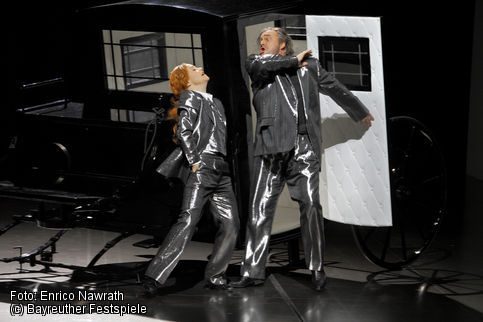 |
| Hans Neuenfels is known to portray sex more or less
graphically on the stage. Here he suggests a very strong sexual
relationship between the Telramunds, a relationship in which the woman –
Ortrud – is obviously the driving force. I was immediately struck by an
ingenious finding. Neuenfels had created a dark contrast to the bridal
chamber scene. In the second act two people for whom Sex was both a
necessity and a plague and for whom “Love” was an unknown notion. For in
the bridal chamber we were to meet two young people clad in white, totally
unexperienced, who dared hardly touch each either although they obviously
wanted to. The male was here the one who made gauche advances towards “the
unknown”, while the bride remained expectingly passive. The contrast with
the “dark” couple” was startling. Before falling in her husbands arms on
the deserted street Ortrud von Telramund had sung all her bitterness and
contempt while riding on the lower hips of the dead grey horse. A
beautiful lesson demonstrating that you cannot equal Love and Sex the way
we are wont to do in our society. |
|
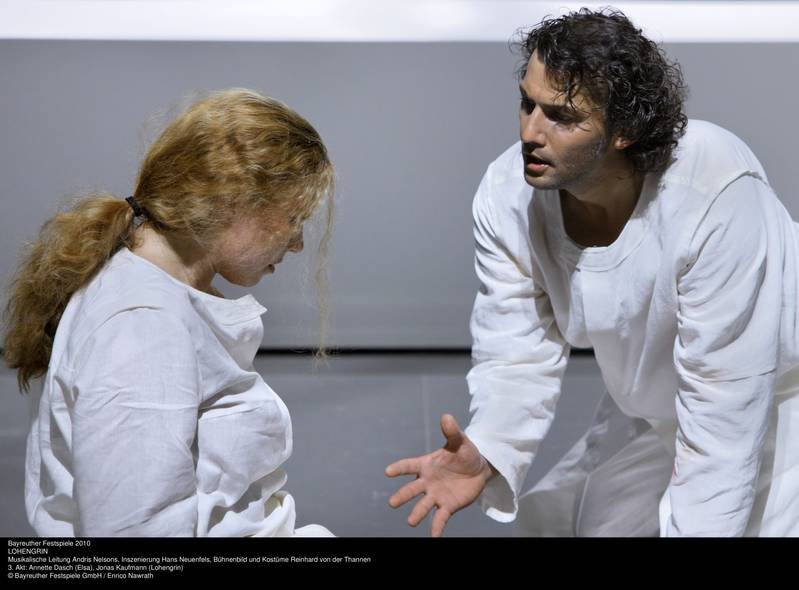 |
| My key worked also for the rest of the evening.
Almost too well. I had read the description of the final scene and seen
pictures which were revolting. The new “leader” – “der arme Bruder”
named Gottfried - , is presented by the departing Lohengrin in the form of
a big embryo concealed in a swan’s egg of unlikely dimensions, an ugly
product of laboratory genes, which frees itself of the umbilical chord
with violent movements, throwing the bits against the audience. The
movements and the features of Lohengrin/Jonas is saying. “This is the
Fuehrer/Schuetzer you ask for and wholly worthy of you. He is entirely a
product of your own.!” |
|
* * * |
| Wagner and his beautiful musical saga had no chance. His
saga is not a superficial one. It has depths other than those we were
offered here and musical qualities which enhance them. Neuenfels staging
is altogether a compromise with Wagner. Would Richard have approved of it?
I think he would. "Ein Kuenstler ganz nach meinem Herzen” as
Placido Domingo said of Jonas.in the preface to the book I bought in
Bayreuth. I have no problem accepting it as a valid alternative, all the
more since I have seen so many good readings more in tune with the music
and the text of Wagner. None perhaps as interesting and challenging to the
intellect as this one. |
|
* * * |
| The reaction of the public has been overwhelmingly
positive. I’m afraid that this is due to the visual elements which are
quite stylish and very professionally conceived. Even the rats are
visually attractive. Hans Neuenfels has a sense of humour and uses it
proficiently. The confrontation between Elsa and Ortud in the second act
is worthy of a Broadway show. The Black Swan and the White Swan meet in a
new choreography with great musical and dramatic conviction. I’m afraid
that many people in the audience, who asked for the meaning of it
all, enjoyed the show immensely. |
|
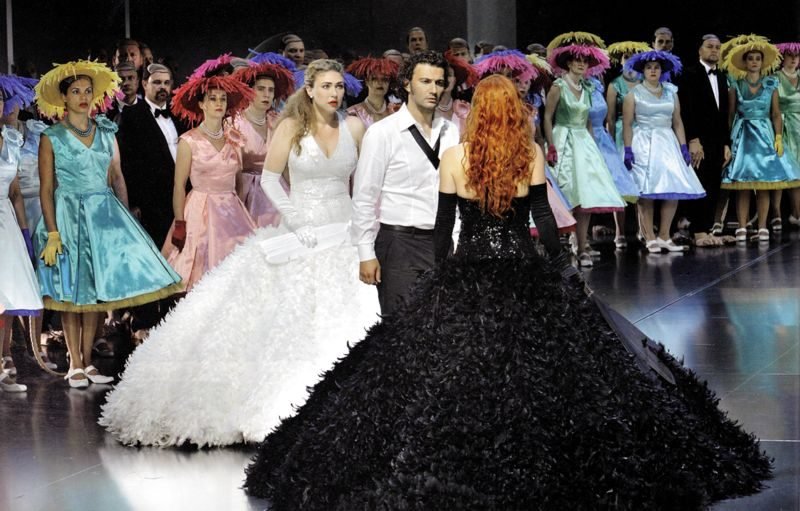 |
|
Musically this performance was the highlight of my stay.
The singing of the chorus is the best in the world. The acoustics of the
hall likewise. Andris Nelsons reading has great class and will
become even better. His attention to the singers and the singing is
“vorbildlich”. The best singing (the musical “genius” (Jonas) apart) came from
King Heinrich – Georg Zeppenfeld. A basso cantante, who didn’t fear
the high tessitura and who sang with intelligent expression, perfect
diction and beautiful tone.
The Ortrud of Evelyn Herlitzius was highly appreciated by the
public. I’m ready to go along after also seeing her. In my loudspeakers I
had heard only a strident, ugly tone with expressive qualities more
attuned to 20th century music than to Wagner. But she is obviously a
full-blood performer. On the stage she convinced me and made me accept her
vocal deficiencies. I can understand that she is a performer sought after
by directors with high dramatic pretensions.
Annette Dasch was not the Elsa of my (maybe Katharina and Ewa
Wagner’s?) dreams, but she is a beautiful performer with a voice just
below the ideal requirements. Elsa needs a full lyric soprano who can bend
and colour her voice also in mezzoforte. The mezzoforte, which should be
the stable foundation of any Jugendlich-Dramatische, is produced with some
effort. She was at her best when she most needed it – in the bridal
chamber. Stimulated by an ideal partner?
Jonas was in as good voice as I have ever heard him. No singer has
ever given to the text so much meaning and has sung the music with such a
wide dynamic range. His pp, ppp and pppp are already legendary. His f, ff
and fff more focused and brilliant than ever. His mastery of the breath
better than that of any tenor today. To me this is his hallmark and
for this I admire him more than I do any other singer today. A totally
worthless judgment, if he wasn’t also a great musician. But he is! |
|
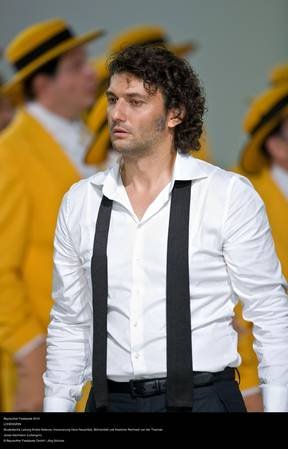 |
| |
|
Article
©
Olle |
| Photos:
© Bayreuther Festspiele |
| |
| |
| |
|
|
|
|
|